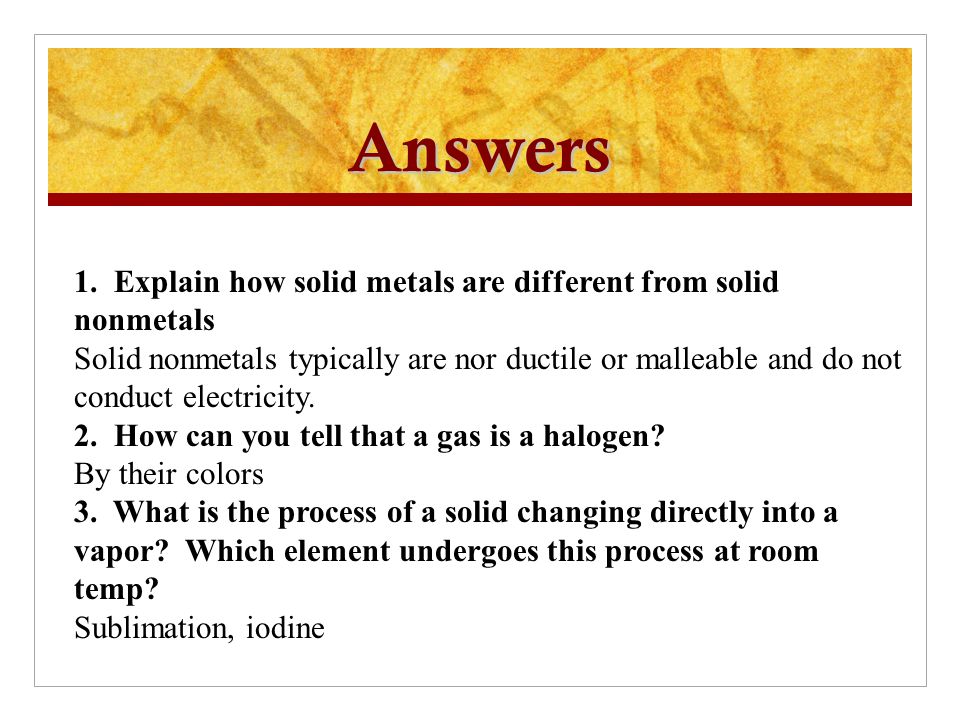Explain How Solid Nonmetals Are Different From Solid Metals
Metals are solid at room temperature highly conductive of heat and electricity and are malleable and ductile in nature. Non-metals can be solid liquid or gaseous at room temperature and are not conductive malleable or ductile.

Solid Nonmetal Solid Metal Gas Nonmetal Solid Metalloid Solid Metal Solid Metal Ppt Download
There is a total of 92 elements that are known to be found naturally.

. Two allotropes of carbon diamond and graphite are recognized as minerals. The low or non-existent electrical conductivity is the most important property that distinguishes non-metals from metals. Explain how metalloids are different from metals and nonmetals.
An element or substance that is not a metal they ade usually gases or solids at room temperature. They are dull and brittle. Name the phase transition in each of the following situations and indicate whether it is exothermic or endothermic.
These are carbon sulphur phosphorus and iodine. This means that the atoms of non-metals have a strong tendency to attract more electrons than what they would normally have. Username E-Mail Password.
Molten lava from a volcano turns into solid rock. Summarize the physical reasons that sound waves travel at different speeds through liquids and gases. Solid nonmetals unlike solid metals are not malleable or ductile are brittle and powdery and are not good conductors of heat and electricity since the electrons in nonmetals are not free to move.
Uses for Metals and Nonmetals. Only four solid non-metals other than perhaps selenium occur naturally as elements. Metals have a high to moderate density whereas non-metals have low to moderate density.
Explain How Solid Nonmetals Are Different From Solid Metals Get link. Difference in Chemical Properties. In contrast to metals solid nonmetals are dull.
Metals and non-metals have different properties. Nonmetals display a wide range of chemical properties and reactivities. Other factors are less favourable.
They are good conductors of electricity and are malleable and ductile. Metals have one to three electrons in their outer shell whereas non-metals have four to eight electrons. Most nonmetals have the ability to gain electrons easily.
But zinc and copper have 42 difference with maximum solubility of 384 wt Zn. Solid metals are hardshiny solids. Metals have a certain luster or shine while non-metals are dull.
Metals have a shiny appearance whereas non-metals are dull in appearance. Except for iodine. Properties of Nonmetals.
Metals are strong and tough. And non-metals are also poor conductors of heat and electricity. Solid nonmetals are dull meaning not shiny and brit-tle meaning not malleable or ductile.
Many non-metals exist as liquids or gases which means that non-metals have low melting and boiling points as compared to metals. Metals are lustrous and can be polished. Nickel and copper of 27 and show complete solid solubility.
Metals like silver and gold have a difference of 02. Strong metals such as iron and metal alloys such as stainless steel are used to build structures ships and vehicles including cars trains and trucks. Nonmetals however come in different colors.
Non-metals exhibit very low electrical conductivities. Non-metals may be solid liquid or gases at the room temperature. The rows of the table are called periods and columns are called groups.
Metaltoids like mercury can become solid and liquid and are called semiconductors. Nonmetals usually have lower densities than metals. FIGURE 20 Physical Properties of Nonmetals.
Non-metals have high electronegativities. Other Apps - April 14 2022 Chemistry Metals And Non Metals 2 Chapter 4 Section 4 Are Poor Conductors Have Reactivity Solid Nonmetals Are Dull Brittle Non Malleable Non Ductile Ppt Download. A molecule that consists of two atoms of the same element.
Under normal conditions some non-metals are found as gases some are found as solids and one is found as liquid ie. Solid nonmetals are generally brittle with little or no metallic luster. There are various different elements present on Earth.
Properties of metals can be explained in terms of metallic structure and bonding. No doubt the buckminsterfullerines and related compounds occur in nature as well but they have not yet been formally described. Cadmium in copper with 165 size difference shows a solid solubility of 17 wt.
Explain how metalloids are different from metals and nonmetals. In their solid state non-metals tend to be brittle. If you hit most solid non-metals with a hammer they break or crumble into a powder.
Name E-Mail. Nonmetals have high ionization energies and electronegativities. Non-metals are non-lustrous dull and cannot be polished.
Metals are solids at room temperatureExcept for mercury which is a liquid metal. They are generally poor conductors of heat and electricity. Explain how solid nonmetals are different from solid metals.
Metals usually come in solid forms while nonmetals can be solid liquid or gas. Non-metals are not strong or tough. Metals generally form basic oxides while nonmetals are good oxidizing agents.
Shiny metals such as copper silver and gold are often used for decorative arts jewelry and coins. Explain how solid nonmetals are different from solid metals. Different chemical models have different features and.
A metals use is directly linked to its qualities. The metals are arranged on the left side and the non-metals on the right side of the periodic table.

Ppt Chapter 3 Section 3 Powerpoint Presentation Free Download Id 1745058

No comments for "Explain How Solid Nonmetals Are Different From Solid Metals"
Post a Comment